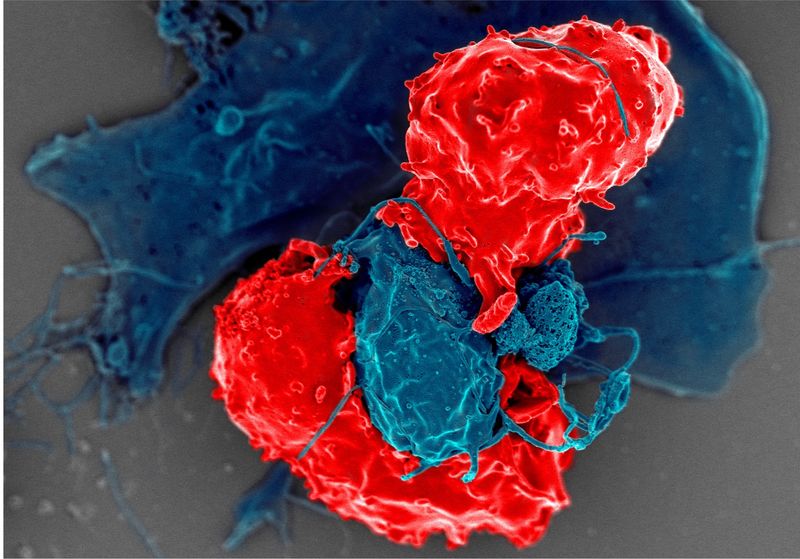Aging is inevitable for most cell types in the human body, but hematopoietic stem cells (HSCs) seem to defy the process. They retain their self-renewing ability almost throughout an organism’s lifetime and exhibit a delayed onset of typical hallmarks of aging like DNA damage or protein aggregation. “Stem cells are really remarkable in their longevity,” said Andre Catic, a researcher working on aging at the Baylor College of Medicine.
Previously, scientists found that one reason contributing to HSC longevity was that they could exist in a functionally inactive state for prolonged periods.1 Now, Catic and his team found another clue as to how these cells maintain their youth. In a study published recently in Nature Cell Biology, they reported that HSCs contain high levels of a protein cyclophilin A which prevents these cells from rapid aging.2 Understanding mechanisms of how HSCs avoid the wear and tear of senescence has wide-ranging implications, from figuring out cells’ fundamental anti-aging secrets to determining how these mechanisms breaking down could lead to leukemia.
Alzheimer’s disease and many other neurodegenerative disorders that occur due to age are caused by proteotoxic insults.3 In these, proteins get misfolded, or clumped together, and their accumulation starts to become troublesome, according to Catic.
“The blood is not really one of the organs that gives us too much trouble when we age; most people, as they age, they get diseases like liver failure, neurodegenerative diseases, things like that,” he said. “There’s no Alzheimer’s in the blood that’s known, right?”
Curious as to why that’s the case, Catic and his team isolated stem and progenitor cells from the bone marrow of mice to see if there was something in their proteome. As aging in other cells is driven by proteins clumping together, they combed the proteome for mechanisms that could cause less protein aggregation or clear up existing protein clumps.
That’s how they came across cyclophilin A, a chaperone that was highly expressed in these HSCs. The scientists found that aged HSCs had lower levels of cyclophilin A, and that genetically removing it from young HSCs accelerated their aging. They also showed that re-introducing cyclophilin A to older HSCs rejuvenated them and improved their functions. All the evidence pointed towards this chaperone playing a key role in the longevity of these stem cells.
“What is interesting is that it’s not one of those chaperones that is active at the back end of proteins’ lives,” said Catic. “Many chaperones, they help misfolded proteins, [they] refold them again, and get them back into solution, or they’re involved in their degradation. Cyclophilin A is involved in the first step of protein synthesis.”
Next, the team further investigated cyclophilin A to better understand its role in translation. When they checked what kinds of proteins it bound to, they found many RNA-binding proteins involved in ribosome assembly. Based on their findings, the scientists hypothesized that cyclophilin A was associated with ribosomes and inferred that it could be helping proteins fold as they come out of the ribosome.
The team also found that this chaperone aided the synthesis of proteins filled with intrinsically disordered regions (IDRs). These indetermined structures within the proteins are also called floppy domains. As they don’t have a very fixed structure, such proteins can adopt whatever conformation is needed, according to Catic.
An advantage of this flexibility is that these proteins can have multiple binding partners; they can act as scaffolding proteins that can bring together other proteins, RNA, and DNA to form complexes in the cell. “They help entire pathways come together, and that is why we believe they’re important for so many basic processes such as splicing and translation,” said Catic.
Catic believes that these intrinsically disordered proteins could be involved in many important cellular functions which help keep the stem cells healthy, which is why cyclophilin A promoting their translation is helpful for the stem cells’ longevity.
Hartmut Geiger, a stem cell biologist at the University of Ulm who was not involved in the study, was intrigued by the authors exploring how proteins are regulated in aging stem cells. Geiger noted, “How can you make sure that this nascent protein chain comes together and folds into a machine, especially the proteins that have floppy domains?”
“To the best of my knowledge, nobody has investigated that because this is a very complicated infrastructure problem, right? How you can really help your most difficult-to- organize protein structures, after they’re produced, to be functional,” he added.
Along with cyclophilin A, Catic was quite stunned to find the intrinsic disorder in the proteome also reduced in older HSCs.
“Maybe this could also be a protective effect, because intrinsically disordered proteins, as important as they are, are also dangerous,” said Catic. “Because they like to bind to other proteins, it makes them aggregation prone, right? And when you look at neurodegenerative diseases, pretty much all of them are based on intrinsically disordered proteins.”
“In Alzheimer’s disease for instance, or Huntington’s disease, these disordered proteins actually start to form aggregates that are so big that they cannot be cleaned up by the cell,” he explained.
Next, Catic wants to explore the mechanisms by which IDR-rich proteins keep the stem cells young. He also wants to delve deeper into the molecular details of what cyclophilin A does to a protein as it comes out of the ribosome, with the hope of one day boosting its expression in aging cells.
“Stem cell aging has previously been mostly defined through cleanup mechanisms with chaperones,” he explained. “What we found is that protein translation is also very tightly regulated by cyclophilin A.”












